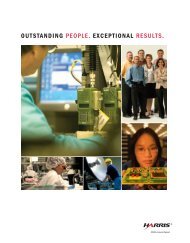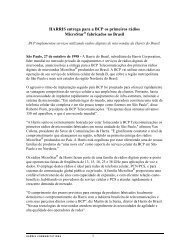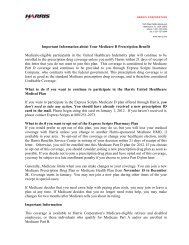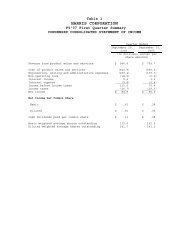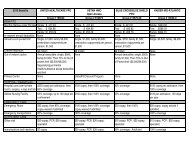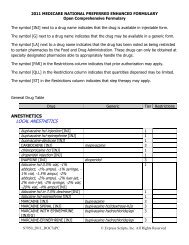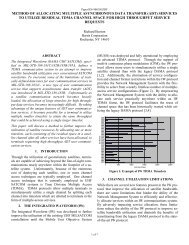harris corporation
harris corporation
harris corporation
Create successful ePaper yourself
Turn your PDF publications into a flip-book with our unique Google optimized e-Paper software.
in fiscal 2011, $721 million in fiscal 2010 and $759 million in fiscal 2009. Company-sponsored research is directed<br />
to the development of new products and services and to building technological capability in selected<br />
communications and electronic systems markets. U.S. Government-funded research helps strengthen and broaden<br />
our technical capabilities. All of our segments maintain their own engineering and new product development<br />
departments, with scientific assistance provided by advanced-technology departments. As of July 1, 2011, we<br />
employed approximately 7,100 engineers and scientists and are continuing efforts to make the technologies<br />
developed in any of our operating segments available for all other operating segments.<br />
Patents and Other Intellectual Property<br />
We consider our patents and other intellectual property, in the aggregate, to constitute an important asset. We<br />
routinely apply for and own a large and valuable portfolio of patents, trade secrets, know-how, confidential<br />
information, trademarks, copyrights and other intellectual property. We also license intellectual property to and from<br />
third parties. As of July 1, 2011, we held approximately 950 U.S. patents and 850 foreign patents, and had<br />
approximately 500 U.S. patent applications pending and 1,140 foreign patent applications pending. Unpatented<br />
research, development and engineering skills also make an important contribution to our business. While our<br />
intellectual property rights in the aggregate are important to our business and the operations of our operating<br />
segments, we do not consider our business or any operating segment to be materially dependent upon any single<br />
patent, license or other intellectual property right, or any group of related patents, licenses or other intellectual<br />
property rights. We are engaged in a proactive patent licensing program and have entered into a number of licenses<br />
and cross-license agreements, some of which generate royalty income. Although existing license agreements have<br />
generated income in past years and may do so in the future, there can be no assurances we will enter into additional<br />
income-producing license agreements. From time to time we engage in litigation to protect our patents and other<br />
intellectual property. Any of our patents, trade secrets, trademarks, copyrights and other proprietary rights could be<br />
challenged, invalidated or circumvented, or may not provide competitive advantages. For further discussion of risks<br />
relating to intellectual property, see “Item 1A. Risk Factors” of this Report. With regard to patents relating to our<br />
Government Communications Systems segment, the U.S. Government often has an irrevocable, non-exclusive,<br />
royalty-free license, pursuant to which the U.S. Government may use or authorize others to use the inventions<br />
covered by such patents. Pursuant to similar arrangements, the U.S. Government may consent to our use of<br />
inventions covered by patents owned by other persons. Numerous trademarks used on or in connection with our<br />
products are also considered to be a valuable asset.<br />
Environmental and Other Regulations<br />
Our facilities and operations are subject to numerous domestic and international laws and regulations designed<br />
to protect the environment, particularly with regard to wastes and emissions. The applicable environmental laws and<br />
regulations are common within the industries and markets in which we operate and serve. We believe that we have<br />
complied with these requirements and that such compliance has not had a material adverse effect on our results of<br />
operations, financial condition or cash flows. Based upon currently available information, we do not expect<br />
expenditures over the next several years to protect the environment and to comply with current environmental laws<br />
and regulations, as well as to comply with current and pending climate control legislation, regulation, treaties and<br />
accords, to have a material impact on our competitive position or financial condition, but we can give no assurance<br />
that such expenditures will not exceed current expectations. If future treaties, laws and regulations contain more<br />
stringent requirements than presently anticipated, actual expenditures may be higher than our present estimates of<br />
those expenditures. We have installed waste treatment facilities and pollution control equipment to satisfy legal<br />
requirements and to achieve our waste minimization and prevention goals. We did not spend material amounts on<br />
environmental capital projects in fiscal 2011, fiscal 2010 or fiscal 2009. A portion of our environmental<br />
expenditures relates to discontinued operations for which we have retained certain environmental liabilities. We<br />
currently expect that amounts to be spent for environmental-related capital projects will not be material in fiscal<br />
2012. These amounts may increase in future years. Additional information regarding environmental and regulatory<br />
matters is set forth in “Item 3. Legal Proceedings” of this Report and in Note 1: Significant Accounting Policies in<br />
the Notes.<br />
Electronic products are subject to governmental environmental regulation in a number of jurisdictions.<br />
Equipment produced by our Integrated Network Solutions segment, in particular, is subject to domestic and<br />
international requirements requiring end-of-life management and/or restricting materials in products delivered to<br />
customers, including the European Union’s Directive 2002/96/EC on Waste Electrical and Electronic Equipment<br />
(“WEEE”) and Directive 2002/95/EC on the Restriction of the use of certain Hazardous Substances in Electrical and<br />
Electronic Equipment (“RoHS”), as amended. Other jurisdictions have adopted similar legislation. Such<br />
requirements typically are not applicable to most equipment produced by our Government Communications Systems<br />
16



